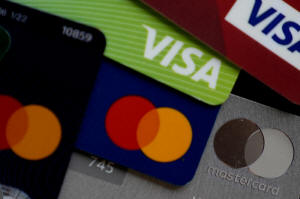Americans would save $100B if credit card rates were capped as Trump
proposed, researchers say
[September 05, 2025] By
KEN SWEET
NEW YORK (AP) — Americans would save roughly $100 billion a year in
interest costs if President Donald Trump’s campaign proposal to cap
credit card interest rates at 10% were implemented, according to a paper
published by Vanderbilt University on Thursday.
Further, the banks and credit card companies would be able to withstand,
and even still be profitable, if there were to be a national cap on
interest rates. While limited in scope, the paper gives some academic
backing to President Trump’s campaign promise.
The paper found that banks would still be able to earn a profit on most
of their customers even if credit card interest rates were capped at
15%, and if the banks continued to offer rewards and perks like points
and airport lounge access. If interest rates were capped at 10%, the
business model gets more difficult for the banks, but they could still
make money off most card customers by cutting back on some rewards.
Usury laws are as old as the Bible but have gotten traction again
through Trump's populist politics. When he was a candidate in the 2024
election, Trump proposed a temporary 10% cap on credit card interest
rates. He has not spoken about it since the election.

That said, politicians have seized on the idea. Sen. Josh Hawley,
R-Missouri, and Vermont Senator Bernie Sanders introduced a bill in
Congress that would match Trump’s campaign proposal of capping interest
rates at 10%. A similar bill was introduced in the House by Rep.
Alexandria Ocasio-Cortez, D-New York.
There are already some interest rate caps in effect in the U.S. The
Military Lending Act makes it illegal to charge active servicemen and
women more than 36% for any financial product. The national regulator
for credit unions, the NCUA, has capped interest rates on credit union
credit cards at 18%.
The banking industry is adamantly against any caps on credit card rates.
Historically, the industry has argued that any cap on interest rates
would decimate the credit card business model and would threaten the
viability of popular rewards and perks programs that millions of
Americans use for free flights and hotel stays.
It was this rhetoric that made Brian Shearer, the author of the report,
start to look into the issue. Shearer previously worked at the Consumer
Financial Protection Bureau as the regulator’s assistant director of
policy planning and strategy, working under Republican and Democratic
administrations.
“I wanted to see if President Trump’s proposed cap could be taken
seriously, and the idea appears that it could be seriously considered
and it would not have the amount of downside that often the pundits
assume there will be,” Shearer said.
[to top of second column] |

Several VISA and MASTER credit cards are shown in Buffalo Grove,
Ill., Thursday, Feb. 8, 2024. (AP Photo/Nam Y. Huh, File)

Americans are carrying more credit card debt than ever before, to the
tune of $1.21 trillion, or roughly $6,400 per person. The average credit
card interest rate is roughly 21%, according to data from the Federal
Reserve. That’s significantly higher than a decade ago, when the average
credit card interest rate was roughly 12%.
Banks earn revenue from credit cards two different ways: the amount of
money they charge merchants to process a credit card transaction, often
referred to as interchange, and the interest and fees the banks charge
customers. That could be the annual fee on a credit card, or the monthly
interest that accrues when a customer carries a balance.
Shearer says the revenue earned from interchange is why banks would
remain profitable, even if credit card interest rates are capped. Credit
card rewards programs are largely funded through interchange. American
Express, for instance, earned $35.2 billion in revenue from the fees
they charge merchants.
Under Shearer’s analysis, if interest rates were capped at 15%,
Americans would save roughly $48 billion in interest a year, while at
10%, that figure goes to $100 billion. In his analysis, Shearer assumed
that banks would charge as close to the national cap as possible.
The Vanderbilt paper finds that banks, because they largely fund their
rewards programs from interchange, would not likely universally cut back
on rewards for Americans. Instead, the Americans who would likely see
the biggest reduction in rewards would be those with low credit scores,
because they are considered the riskiest borrowers. However, Shearer
believes that any modest reduction in rewards for those customers would
likely be made up in the interest they would save annually.
Historically, bank customers with low credit scores tend to be
"revolvers", or those who carry a balance, instead of “transactors,”
which are customers who pay off their credit cards at the end of each
month.

“It is true that there would need to be some reward reduction, but it’s
not the kind of sky-is-falling story that you often hear,” Shearer said.
The paper was produced out of the Vanderbilt Policy Accelerator, an arm
of Vanderbilt University. The Accelerator is designed to do research
into trending political topics to see if those policy ideas might be
viable and see how they might be implemented.
All contents © copyright 2025 Associated Press. All rights reserved |